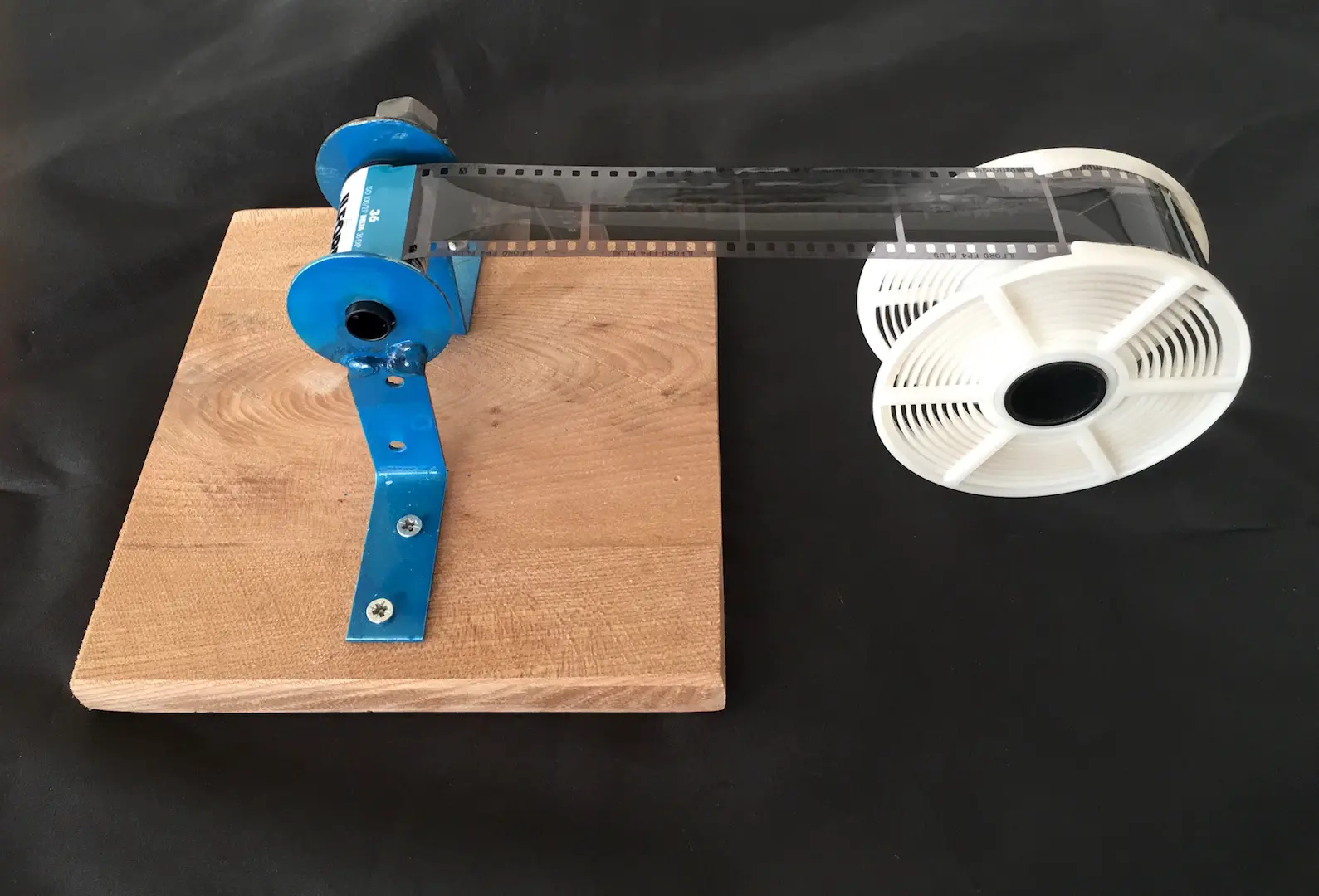Following on from the Parallax review of the Paterson reel system, I thought I would share a few quick tips and a little home made device a use for helping load one. This might not work for everyone, but it works very well for me. First, a few tips around the equipment I use:
I use a film changing bag to load the film on to the spool and into the tank. If there is one thing i have learned about this process it is to avoid small film changing bags. I had mine made in Jordan for 10.00 GBP but you can buy one on ebay for about twice that (65 cm x 65 cm). A smaller bag is workable but the height of the tank compresses the “free space” and you may end up struggling with it (as I did). Plus your hands can get hot (quickly): sweat and film are not a good mix.
Buy a proper film can opener. Yes, you can pull the film back through the felt strips (if you left the leader out) but the film has already made that trip twice and there is a risk of damaging the emulsion if there is any micro-grit/debris on the felt. When the requirement comes to cut the film from the spool, use small yet sharp scissors for cutting the film straight with one cut.
My DIY spooler
All of this equipment is readily available off the shelves. What isn’t available commercially is a little tool I’ve made to help keeps the film straight going onto the reel. I have made several film spoolers in the past (latest version below) – you could probably make one out of lego, wood or plastic might also do. My latest version has a side-bolt so I can can adjust the spooling tension (“goldilocks tension” means you just ratchet the reel and the film feeds in nicely). Without the spooler you may have to multi-task and keep adjusting the “feed” into the reel – the less your hands need to move the better.
This photo is just to help give you an idea of how the setup works. As mentioned, in practice the film is not contained within the canister – it’s also (obviously) not already developed… Hopefully you the gist: “hands-free” with tangential film exit & entry: 30 seconds of “jiggling” to complete the task.

Preparation
The most critical item is the reel. Mind you, I have never tried anything other than the Paterson that I own; it works, and I suppose alternatives could be better/easier, but I don’t want to accumulate more equipment (“use what you got”). I clean the reel with a toothbrush and fairly liquid after use, rinse, and leave to dry – it must be perfectly dry if you want to avoid it getting jammed when loading. I then jiggle the two ball bearings back and forth with a compass point to make sure they are truly free – if they are not you may have problems with the next film.
In preparation I lay everything out in the same place every time – on top of the bag as a visual check. I then put it all inside in the same positions – groping around in the dark soon becomes a thing of the past. Tip: Remove you watch before inserting arms in the bag.

Procedure
I shan’t double up on the Parallax post. The only difference for me is loading the film into the spooler before picking up the reel and inserting the film end. Just remember to clean and dry everything thoroughly when done, and shake out the film bag.
If there are alternate/better methods of handling let me know? New tricks always welcome here!
Cheers – Guy
Share this post:









Comments
Terry B on Tips and a DIY tool for film loading using a 35mm Paterson Tank System – guest post by Guy
Comment posted: 15/10/2017
Yes, remove the film from the cassette, yes, ensure that the reels are scrupulously dry, yes, have a medium to large changing bag, but once the little knack has been learned, and it isn't rocket science, about introducing the film onto the reel, actual loading thereafter is automatic by a simple jiggling of the reels.
And, as I've alluded to in another post, for anyone who has any concerns about doing all this in the dark, why not search for a Jobo 2400 daylight loading tank? Just remember to leave the film leader out when rewinding, it still needs this, but if one uses an auto rewinding camera, it may completely rewind the film. In this case, use a little film leader retrieval too and with a little practice, and patience, the leader will come out.
Comment posted: 15/10/2017
Comment posted: 15/10/2017
Comment posted: 15/10/2017
Andrew Gronow on Tips and a DIY tool for film loading using a 35mm Paterson Tank System – guest post by Guy
Comment posted: 15/10/2017
Comment posted: 15/10/2017
Comment posted: 15/10/2017
Mark on Tips and a DIY tool for film loading using a 35mm Paterson Tank System – guest post by Guy
Comment posted: 22/04/2018
The biggest remaining problem is moisture. It reaches upto 30c in summer here and just the sweat from my hands can drench the inside of the dark bag when loading a four reel tank :-/
Melvin on Tips and a DIY tool for film loading using a 35mm Paterson Tank System – guest post by Guy
Comment posted: 18/09/2021